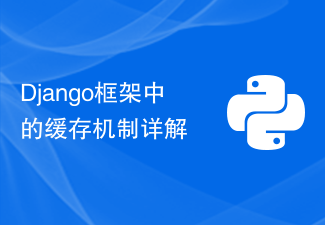 Backend Development
Backend Development Golang
Golang Core tuning methods to solve the bottleneck of Go language website access speed
Core tuning methods to solve the bottleneck of Go language website access speedCore tuning methods to solve the bottleneck of Go language website access speed
With the development of the Internet, website access speed has become more and more important to user experience. As an efficient and easy-to-write programming language, Go language has gradually been widely used in Web development. However, even websites written in Go may still face access speed bottlenecks. This article will introduce the core tuning methods to solve the bottleneck of Go language website access speed, and provide relevant code examples.
1. Use concurrent processing to improve speed
Go language inherently supports concurrency. By using goroutine and channel, efficient concurrent processing can be achieved. In website development, concurrent processing can be used to improve access speed. The following is a sample code using goroutine:
func handleRequest(w http.ResponseWriter, r *http.Request) {
// 处理请求的逻辑
}
func main() {
http.HandleFunc("/", handleRequest)
http.ListenAndServe(":8080", nil)
}By placing specific request processing logic in goroutine, multiple concurrent requests can be processed at the same time, thereby improving the response speed of the website.
2. Reduce memory allocation
In the Go language, memory allocation is a relatively slow operation. Frequent memory allocation may cause bottlenecks in website access speed. To improve access speed, memory allocation can be minimized. The following is a sample code for using sync.Pool to reuse objects:
type MyObject struct {
// 对象的字段
}
var myObjectPool = sync.Pool{
New: func() interface{} {
return &MyObject{}
},
}
func handleRequest(w http.ResponseWriter, r *http.Request) {
obj := myObjectPool.Get().(*MyObject)
defer myObjectPool.Put(obj)
// 处理请求的逻辑
}
func main() {
http.HandleFunc("/", handleRequest)
http.ListenAndServe(":8080", nil)
}By using sync.Pool to cache objects that need to be frequently created and destroyed, the number of memory allocations can be reduced, thereby improving the access speed of the website. .
3. Optimize database access
In website development, database access is often a time-consuming operation. In order to improve the access speed of the website, the performance of database access can be optimized. The following is a sample code that uses a connection pool to optimize database access:
var db *sql.DB
func handleRequest(w http.ResponseWriter, r *http.Request) {
// 使用数据库连接执行操作
}
func main() {
var err error
db, err = sql.Open("mysql", "username:password@tcp(localhost:3306)/dbname")
if err != nil {
log.Fatal(err)
}
defer db.Close()
db.SetMaxIdleConns(10)
db.SetMaxOpenConns(100)
http.HandleFunc("/", handleRequest)
http.ListenAndServe(":8080", nil)
}By setting the maximum number of idle connections and the maximum number of open connections in the connection pool, database connection resources can be reasonably utilized, thereby improving the performance of database access.
To sum up, by using concurrent processing, reducing memory allocation and optimizing database access, the bottleneck problem of Go language website access speed can be effectively solved. The sample code provided above is for reference only. The specific tuning method should be flexibly selected and adjusted according to the actual situation.
(Note: The above codes and methods are for reference only. The specific implementation may vary depending on the environment and needs. It is recommended to use it with caution in actual projects.)
The above is the detailed content of Core tuning methods to solve the bottleneck of Go language website access speed. For more information, please follow other related articles on the PHP Chinese website!
 Golang中实现高效电商推荐算法的缓存机制。Jun 20, 2023 pm 08:33 PM
Golang中实现高效电商推荐算法的缓存机制。Jun 20, 2023 pm 08:33 PM随着电商业务的蓬勃发展,推荐算法成为了各大电商平台竞争的关键之一。作为一门高效、高性能语言,Golang在实现电商推荐算法方面有着很大的优势。但是,在实现高效推荐算法的同时,缓存机制也是一个不可忽视的问题。本文将介绍如何在Golang中实现高效电商推荐算法的缓存机制。一、为什么需要缓存机制在电商推荐算法中,推荐结果的生成需要耗费大量的计算资源,对于高并发的电
 Django框架中的缓存机制详解Jun 18, 2023 pm 01:14 PM
Django框架中的缓存机制详解Jun 18, 2023 pm 01:14 PM在Web应用程序中,缓存通常是用来优化性能的重要手段。Django作为一款著名的Web框架,自然也提供了完善的缓存机制来帮助开发者进一步提高应用程序的性能。本文将对Django框架中的缓存机制进行详解,包括缓存的使用场景、建议的缓存策略、缓存的实现方式和使用方法等方面。希望对Django开发者或对缓存机制感兴趣的读者有所帮助。一、缓存的使用场景缓存的使用场景
 java缓存机制有哪些Nov 16, 2023 am 11:21 AM
java缓存机制有哪些Nov 16, 2023 am 11:21 AMjava缓存机制有内存缓存、数据结构缓存、缓存框架、分布式缓存、缓存策略、缓存同步、缓存失效机制以及压缩和编码等。详细介绍:1、内存缓存,Java的内存管理机制会自动缓存经常使用的对象,以减少内存分配和垃圾回收的开销;2、数据结构缓存,Java内置的数据结构,如HashMap、LinkedList、HashSet等,具有高效的缓存机制,这些数据结构使用内部哈希表来存储元素等等。
 阿里云缓存机制有哪些Nov 15, 2023 am 11:22 AM
阿里云缓存机制有哪些Nov 15, 2023 am 11:22 AM阿里云缓存机制有阿里云Redis、阿里云Memcache、分布式缓存服务DSC、阿里云Table Store、CDN等。详细介绍:1、阿里云Redis:阿里云提供的分布式内存数据库,支持高速读写和数据持久化。通过将数据存储在内存中,可以提供低延迟的数据访问和高并发的处理能力;2、阿里云Memcache:阿里云提供的高速缓存系统等等。
 Golang中实现高效在线广告投放算法的缓存机制。Jun 21, 2023 am 08:42 AM
Golang中实现高效在线广告投放算法的缓存机制。Jun 21, 2023 am 08:42 AMGolang作为一门高效的编程语言,近年来受到越来越多开发者的欢迎,并在各种场景下被广泛应用。在广告平台场景中,为了实现精准的广告投放,需要对广告的选择、排序、过滤等流程进行快速的计算,以达到高效的广告投放目的。而为了优化这个流程,缓存机制成为了不可避免的一部分。一般而言,广告平台的流程大概如下:当用户在浏览网页时,广告平台通过各种方式收集到用户的信息,并通
 浏览器缓存机制有哪些Nov 15, 2023 pm 03:25 PM
浏览器缓存机制有哪些Nov 15, 2023 pm 03:25 PM浏览器缓存机制有强缓存、协商缓存、Service Worker和IndexedDB等。详细介绍:1、强缓存,浏览器在请求资源时,会先检查本地缓存是否存在该资源的副本,并且该副本是否过期,如果资源的副本未过期,浏览器就直接使用本地缓存,不会向服务器发送请求,从而加快了网页加载速度;2、协商缓存,当资源的副本过期或者浏览器的缓存被清除时,浏览器会向服务器发送请求等等。
 html缓存机制有哪些Nov 15, 2023 pm 05:58 PM
html缓存机制有哪些Nov 15, 2023 pm 05:58 PMhtml缓存机制有浏览器缓存、缓存HTTP头、Expires、ETag、Last-Modified等。详细介绍:1、浏览器缓存,是一种基于浏览器的缓存机制,它将之前访问过的网页内容存储在用户的计算机上,以便在下次访问时能够更快地加载和显示网页内容;2、缓存HTTP头,是HTTP/1.1规范中的一种缓存机制,它通过设置响应头来控制浏览器对资源的缓存行为;3、Expires等等。
 http缓存机制有哪些Nov 16, 2023 am 10:48 AM
http缓存机制有哪些Nov 16, 2023 am 10:48 AMhttp缓存机制有缓存头、缓存策略、缓存命中、缓存失效、缓存回收、缓存一致性、缓存替换策略、代理缓存、浏览器缓存、压缩和编码、CDN缓存等。详细介绍:1、缓存头,是HTTP请求和响应中包含的元数据,用于控制缓存的行为;2、缓存策略,Web服务器使用缓存策略来确定如何处理缓存请求;3、缓存命中,当浏览器再次请求相同的资源时,如果该资源已经在缓存中可用,则浏览器会直接从缓存中等等。


Hot AI Tools

Undresser.AI Undress
AI-powered app for creating realistic nude photos

AI Clothes Remover
Online AI tool for removing clothes from photos.

Undress AI Tool
Undress images for free

Clothoff.io
AI clothes remover

AI Hentai Generator
Generate AI Hentai for free.

Hot Article

Hot Tools

SAP NetWeaver Server Adapter for Eclipse
Integrate Eclipse with SAP NetWeaver application server.

MinGW - Minimalist GNU for Windows
This project is in the process of being migrated to osdn.net/projects/mingw, you can continue to follow us there. MinGW: A native Windows port of the GNU Compiler Collection (GCC), freely distributable import libraries and header files for building native Windows applications; includes extensions to the MSVC runtime to support C99 functionality. All MinGW software can run on 64-bit Windows platforms.

VSCode Windows 64-bit Download
A free and powerful IDE editor launched by Microsoft

MantisBT
Mantis is an easy-to-deploy web-based defect tracking tool designed to aid in product defect tracking. It requires PHP, MySQL and a web server. Check out our demo and hosting services.

mPDF
mPDF is a PHP library that can generate PDF files from UTF-8 encoded HTML. The original author, Ian Back, wrote mPDF to output PDF files "on the fly" from his website and handle different languages. It is slower than original scripts like HTML2FPDF and produces larger files when using Unicode fonts, but supports CSS styles etc. and has a lot of enhancements. Supports almost all languages, including RTL (Arabic and Hebrew) and CJK (Chinese, Japanese and Korean). Supports nested block-level elements (such as P, DIV),





